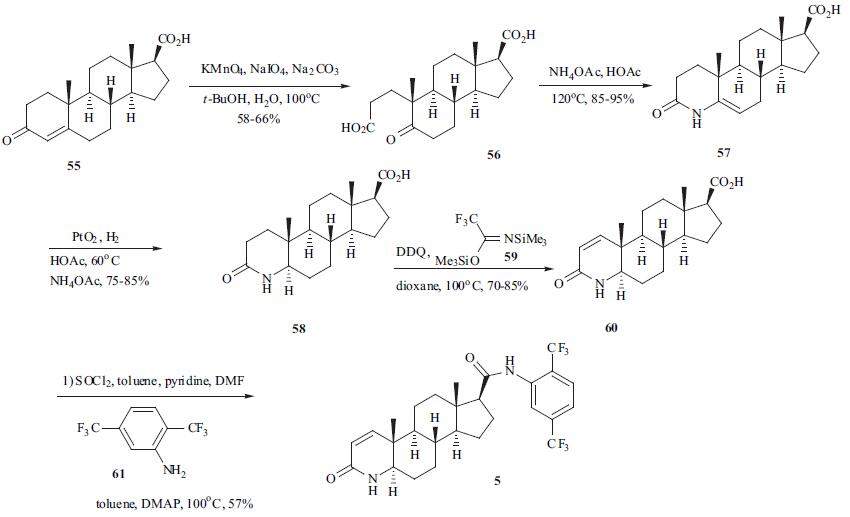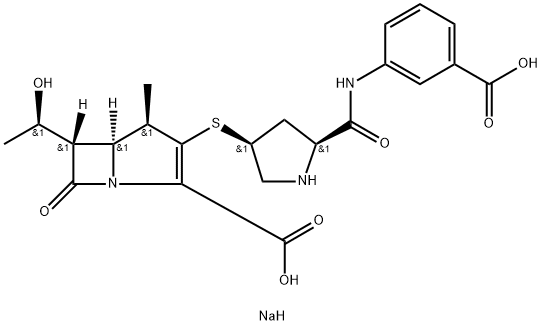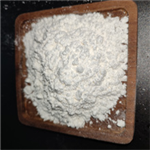Ertapenem sodium was introduced in the US as a once daily intravenous or
intramuscular injection for the treatment of adult patients with moderate to severe bacterial
infections. This new I-β-methyl carbapenem can be assembled from commercially
available 4-nitrobenzyl protected β-methyl carbapenem enolphosphate and the appropriate
thiol derivative. The last intermediate can be synthesized from a suitably N-protected 4-
hydroxy proline derivative in a one pot operation involving bis activation of the carboxy and
hydroxy groups, reaction with sodium sulfide yielding the corresponding thiolactone,
aminolysis with 2-aminobenzoic acid and Kdeprotection. This bacterial cell wall synthesis
inhibitor has broad spectrum antimicrobial activity including common Gram-positive and
Gram-negative aerobic pathogens and restricted activity against nosocomial pathogens
such as Pseudomonas aeruginosa, Acinetobacfer species, methicillin-resistant
staphylococci and enterococci. Ertapenem is resistant to a broad and extended spectrum
of β-lactamases (excluding metallo-beta-lactamase) and is also more resistant than
imipenem to human renal dehydroxypeptidase-I-inactivation (DHP-I). In drug-resistant
strains of P. aeruginosa, resistance to ertapenem and imipenem was common but almost
all strains remain susceptible to at least one antipseudomal agent. In phase III studies,
ertapenem showed efficacy in the treatment of obstetric and gyneacological infections,
skin and soft tissues infections, community-acquired pneumonia, urinary tract infections
and in intra abdominal infections. Ertapenem has improved pharmacokinetics over
currently available carbapenems and cephalosporins with an extended serum half-life of 4h. The overall safety and tolerability profile of ertapenem was comparable to that seen with
comparator antibacterials.
Group 1 carbapenem antibiotic. An antibacterial.
Following a conventional carbapenem synthetic strategy,
ertapenem sodium (6) can be assembled from 4-nitrobenzylprotected
|?-methyl carbapenemenolphosphate 71 and 2-
aminocarbonylpyrrolidine-4-ylthio-containing side chain 70.
Many efficient approaches to 71 have been reported in the
literature , and this compound is now commercially
available on a large scale. The synthesis of 70 is
outlined in the scheme. Protection of the amino group
in trans-4-hydroxy-L-proline (62) with diisopropyl
phosphite followed by NaClO oxidation gave N-DIPP
protected hydroxyl proline 63 in 80% yield. The carboxyl
group in 63 was activated via reaction with
diphenylphosphinic chloride (DPPC) in the presence of
diisopropylethylamine (DIPEA). This intermediate 64 was
directly reacted with methanesulfonyl chloride in the presence of pyridine to furnish mesylate 65. Mesylate 65
was then quenched with aqueous sodium sulfide yielding 66
instantaneously, which then slowly cyclized to 67.
Aminolysis of 67 with m-aminobenzoic acid (68) and
subsequent deprotection of the DIPP group with
concentrated HCl provided 70 in 90-95% yield in a one-pot
process. The coupling reaction between 70 and 71 followed
by deprotection of PNB group was completed in one
reaction vessel to furnish ertapenem sodium (6) (yield was
not disclosed).

in e.coli, ertapenem binds to penicillin binding proteins (pbps) 1a, 1b, 2, 3, 4 and 5, showing highest affinity for pbps 2 and 3 [1]. mic90s for most species of enterobacteriaceae were < 1 mg/l. mic90s for most bacteroides fragilis group isolates ranged from 1 to 4 mg/l, and mic90s were species specific for clostridium, ranging from 0.06 mg/l for clostridium perfringens to 4 mg/l for clostridiumclostridioforme [2].
in healthy young men and women volunteers, the mean concentration of ertapenem in plasma ranged from ~145 to 175 μg/ml at the end of a 30-min infusion, from ~30 to 34 μg/ml at 6 h, and from ~9 to 11 μg/ml at 12 h. the mean plasma t1/2 ranged from 3.8 to 4.4 h. about 45% of the plasma clearance (clp) was via renal clearance [3].
[1]. shah p m, isaacs r d. ertapenem, the first of a new group of carbapenems[j]. journal of antimicrobial chemotherapy, 2003, 52(4): 538-542.
[2]. wexler h m. in vitro activity of ertapenem: review of recent studies[j]. journal of antimicrobial chemotherapy, 2004, 53(suppl 2): ii11-ii21.
[3]. majumdar a k, musson d g, birk k l, et al. pharmacokinetics of ertapenem in healthy young volunteers[j]. antimicrobial agents and chemotherapy, 2002, 46(11): 3506-3511.




